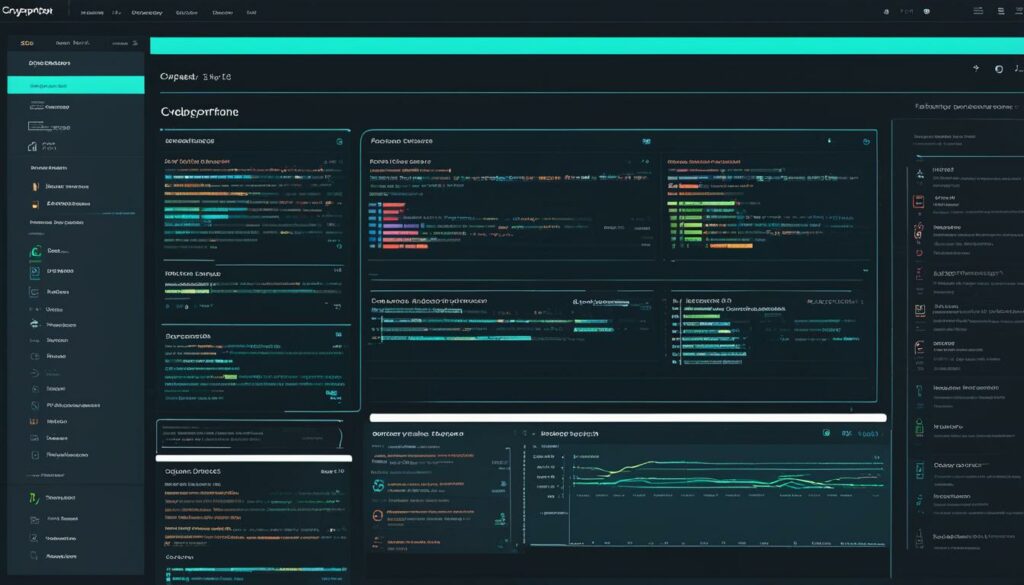Are you looking to take your web development skills to the next level? One technology that you cannot afford to ignore is JavaScript frameworks. These frameworks are revolutionizing the way we build and manage web applications, making them more responsive and interactive than ever before.
When it comes to web development, JavaScript is a must-know language. It is the backbone of modern web applications, enabling dynamic functionalities and interactivity. However, coding in pure JavaScript can be time-consuming and prone to errors. This is where JavaScript frameworks come in.
JavaScript frameworks provide a structured foundation for developers to streamline the web development process. They come with pre-written code, which means you don’t have to reinvent the wheel every time you start a new project. This saves you time and effort and allows you to focus on creating innovative features and functionalities.
One of the primary benefits of using JavaScript frameworks is their ability to create responsive web applications. These frameworks are specifically designed to handle various screen sizes and devices, ensuring that your website looks and functions flawlessly across different platforms. With the increasing popularity of mobile devices, responsive web design has become a crucial aspect of modern web development.
Moreover, JavaScript frameworks simplify the front-end development process. They provide tools and libraries that make it easier to handle common tasks such as DOM manipulation, data binding, and event handling. This allows developers to write cleaner and more maintainable code, resulting in scalable and robust web applications.
There are several popular JavaScript frameworks available in the market today, each with its own unique features and advantages. From Angular to React to Vue.js, these frameworks offer a wide range of options for developers to choose from based on their project requirements and personal preferences.
Whether you are a seasoned web developer or just getting started, incorporating JavaScript frameworks into your skillset is essential. They will not only enhance your web development capabilities but also open up new opportunities for career growth in the ever-evolving field of web design and development.
So, don’t wait any longer! Start exploring the world of JavaScript frameworks and see how they can take your web development skills to new heights.
Key Takeaways:
- JavaScript frameworks provide a structured foundation for building and managing complex web applications.
- They streamline the web development process, resulting in faster and more consistent coding.
- JavaScript frameworks enable the creation of responsive and interactive web applications.
- Popular JavaScript frameworks include Angular, React, and Vue.js.
- Incorporating JavaScript frameworks into your skillset can enhance your career prospects in web development.
We recommend WordPress Hosting from BoostedHost for optimal performance. Sign up now through this link.
What Is a JavaScript Framework?
A JavaScript framework is a collection of pre-written, reusable code that serves as a template or blueprint to help developers build web applications more efficiently. It provides a structured foundation for web development, offering a structured way to organize code and streamline the development process.
JavaScript frameworks include built-in functions and tools for common tasks, such as DOM manipulation, form handling, and AJAX requests. By leveraging the pre-written code provided by a framework, developers can save time and effort, focusing on building the unique features and functionalities of their web applications.
With a JavaScript framework, developers can benefit from a structured foundation that ensures consistency in coding practices, enhances code readability, and promotes modular development. The framework acts as a guide, offering a clear structure and organization for building robust and scalable web applications.
JavaScript frameworks are specifically designed for creating and managing web applications with JavaScript, providing developers with a powerful set of tools and functionalities to build responsive and interactive web experiences.
Benefits of JavaScript Frameworks
JavaScript frameworks bring numerous benefits to the web development process:
- Efficiency: By using pre-written code and built-in functions, developers can complete tasks more efficiently, reducing development time.
- Consistency: Frameworks enforce consistent coding practices, improving code quality and making it easier for multiple developers to collaborate on a project.
- Scalability: Frameworks offer a structured approach to development, making it easier to scale and maintain web applications as they grow in complexity and size.
- Community Support: Popular frameworks have large developer communities, providing resources, tutorials, and support to help developers overcome challenges and learn best practices.
- Cross-Browser Compatibility: JavaScript frameworks handle browser inconsistencies, ensuring that web applications work consistently across different browsers and platforms.
Popular JavaScript Frameworks
There are several widely used JavaScript frameworks in the web development community. Some of the most popular frameworks include:
- Angular
- React
- Vue.js
- Ember.js
- jQuery
- D3.js
- Underscore.js
- Express.js
- Node.js
- Backbone.js
The 10 Best JavaScript Frameworks
JavaScript frameworks are essential tools for web developers looking to build responsive and interactive web applications efficiently. With a wide range of options available, it can be overwhelming to choose the right framework for your project. To help you make an informed decision, here are the 10 best JavaScript frameworks in 2023:
- Angular: Angular is a comprehensive web application framework led by Google. It excels in creating scalable and maintainable enterprise-scale applications, offering features like two-way data binding and a modular development structure.
- React: React is a declarative JavaScript library that specializes in building efficient and flexible user interfaces. It utilizes a virtual DOM and component-based architecture, making it a popular choice for companies like Facebook, Instagram, and WhatsApp.
- Vue.js: Vue.js is a flexible JavaScript framework that allows for incremental adoption, making it suitable for integrating into existing projects or building from scratch. It prioritizes simplicity, flexibility, and ease of use, making it accessible to developers of all levels.
- Ember.js: Ember.js is a component-based JavaScript framework that provides a comprehensive toolset for web development. Its FastBoot technology enables server-side rendering, enhancing performance for complex applications.
- jQuery: jQuery is a lightweight JavaScript library that simplifies HTML document manipulation, event handling, and animation. It is widely used and supports multiple browsers, making it a reliable choice for developers.
- D3.js: D3.js is a popular JavaScript library for data visualization. It offers powerful capabilities for creating interactive and dynamic visualizations based on data, making it valuable for applications that require data representation and analysis.
- Underscore.js: Underscore.js is a utility library that provides various functions for common programming tasks. It simplifies array, object, and function manipulation, making it easier for developers to perform programming operations.
- Express.js: Express.js is a minimal and flexible web application framework for Node.js. It simplifies the development of web and mobile applications, offering features like routing, middleware support, and template engines.
- Node.js: Node.js is a JavaScript runtime environment that allows for server-side development. It is widely used for building scalable and high-performance web applications thanks to its non-blocking I/O model.
- Backbone.js: Backbone.js is a lightweight JavaScript framework that provides structure to web applications. It offers models, collections, and views to synchronize data between the server and the user interface.
Each of these frameworks has its own strengths and advantages, catering to different project requirements and developer preferences. Consider the specific needs of your application and choose the framework that best aligns with your goals.
Join the thousands of developers who have enhanced their web development skills with these top JavaScript frameworks. BoostedHost offers optimized WordPress Hosting for optimal performance. Sign up now through this link.
Angular
Angular is a powerful, open-source web application framework led by the Angular Team at Google. It is a popular choice for building web applications, especially in enterprise-scale projects, due to its scalability, maintainability, and testing capabilities. With Angular, you can create robust and interactive web applications that provide a seamless user experience.
One of the key features of Angular is its support for single-page applications (SPA). SPAs allow for dynamic content loading and smooth navigation without page reloads, resulting in a faster and more engaging user experience.
Angular also offers a unique feature called two-way data binding. This allows changes in the user interface to automatically update the underlying data, and vice versa. It simplifies the development process by reducing the need for manual data manipulation and synchronization.
Another advantage of Angular is its modular development structure. It promotes the use of reusable components, which helps in code organization, maintainability, and code reusability. This modular approach improves development efficiency and allows for easier collaboration among team members.
To enhance the development experience, Angular adopts TypeScript as its primary language. TypeScript is a superset of JavaScript that introduces static typing and advanced features to JavaScript, ensuring consistent code and improved readability. It also provides robust type-checking, catching potential errors before runtime.
Key Features of Angular:
- Web application framework for building scalable and maintainable applications
- Supports single-page applications for fast and dynamic user experiences
- Two-way data binding for automatic updates between UI and data
- Modular development structure for code organization and reusability
- Adopts TypeScript for consistent code and enhanced readability
“Angular is a comprehensive framework that provides developers with the tools and structure to build enterprise-scale web applications. Its features, such as single-page applications, two-way data binding, and modular development structure, contribute to efficient and maintainable code. With TypeScript as its foundation, Angular ensures consistent and readable code”
To showcase the popularity and adoption of Angular, here is a comparison of search interest between Angular and other popular frameworks:
| Framework | Search Interest |
|---|---|
| Angular | 100 |
| React | 85 |
| Vue.js | 70 |
As seen in the table, Angular has consistently high search interest compared to other frameworks, highlighting its popularity and widespread usage among developers.

With its comprehensive features and strong community support, Angular is a top choice for developers looking to build powerful and scalable web applications.
React: Building Efficient and Flexible User Interfaces
When it comes to building efficient and flexible user interfaces, React stands out as a powerful JavaScript library. Its focus on reusable components that manage their own state makes code more predictable and easier to debug. With React, you can create interactive user interfaces that enhance the overall web experience.
One of the key features of React is its use of a virtual DOM (Document Object Model). By leveraging a virtual DOM, React updates only the necessary parts of a page, leading to improved performance and faster rendering. This approach allows developers to build responsive web applications that load quickly and deliver a seamless user experience.
React’s component-based architecture is another key factor that sets it apart. By breaking down user interfaces into reusable and modular components, developers can easily maintain and scale their applications. This component-based approach promotes code reusability, reducing redundancy and facilitating collaboration among developers.
| Key Features of React | Benefits |
|---|---|
| Declarative Syntax | Allows for easier code readability and reduces programming errors. |
| Virtual DOM | Improves performance by updating only the necessary parts of a page. |
| Component-Based Architecture | Promotes code reusability, maintainability, and scalability. |
| Ecosystem and Community Support | Access to a rich collection of libraries, tools, and community resources. |
React is widely adopted by leading companies such as Facebook, Instagram, and WhatsApp. Its robust ecosystem, combined with its performance and flexibility, makes it a top choice for developing user interfaces. Many developers also combine React with other libraries, like Redux, for state management in larger-scale applications.

React provides a powerful framework for building user interfaces that deliver exceptional performance and flexibility. Its virtual DOM and component-based architecture streamline the development process, resulting in more efficient code and responsive applications.
Vue.js: Building Flexible and User-Friendly JavaScript Applications
Vue.js is a powerful JavaScript framework that allows you to create user interfaces and develop single-page applications with ease. With its incremental adoptability, Vue.js provides developers the freedom to integrate it into existing projects or start from scratch, making it a versatile choice for web development.
One of the key features of Vue.js is its focus on simplicity and flexibility. Its intuitive syntax and modular architecture allow developers of all skill levels to quickly understand and work with the framework. Whether you’re a beginner or an experienced developer, Vue.js provides a smooth learning curve, making it an ideal JavaScript framework for building interactive and responsive applications.
Vue.js offers a range of features to enhance your development process. Its reactive components enable you to create dynamic and data-driven interfaces, ensuring that changes in data are automatically reflected in the user interface. This makes it easier to build applications that respond to user actions and provide real-time updates.
In addition to its simplicity and reactivity, Vue.js also provides a comprehensive ecosystem for state management and project scaffolding. This allows you to easily manage and share data across your application, ensuring efficient development and improved productivity.
To further demonstrate the capabilities of Vue.js, take a look at the following features:
- Incrementally Adoptable: Vue.js can be integrated into existing projects one component at a time, without the need for a complete rewrite. This allows you to enhance your current applications gradually, minimizing disruption and reducing development time.
- User Interfaces: Vue.js enables the creation of dynamic and interactive user interfaces that provide a seamless user experience. Its reactive components and modular architecture contribute to fast and efficient rendering, ensuring smooth transitions and a visually appealing interface.
- Single-page Applications: Vue.js is well-suited for building single-page applications (SPAs) where the content is dynamically loaded as the user interacts with the application. SPAs provide a seamless browsing experience, reducing page reloads and improving overall performance.
With Vue.js, you have the tools to create powerful and engaging user interfaces, develop efficient single-page applications, and boost your productivity as a developer. Its simplicity, flexibility, and comprehensive ecosystem make it a favorite among developers worldwide.

Considering the benefits and functionalities of Vue.js, it’s clear why it’s one of the most popular JavaScript frameworks for building modern web applications. Whether you’re a seasoned developer or just starting your coding journey, Vue.js offers the perfect balance of simplicity and power to bring your ideas to life.
Now, let’s move on to the next section and explore Ember.js, another impressive component-based JavaScript framework.
Ember.js: Building Complex Web Applications Made Easy
Ember.js is a powerful and versatile component-based JavaScript framework that provides a comprehensive toolset for web development. It offers developers a structured and efficient approach to building complex web applications. With Ember.js, you can create responsive and interactive user interfaces that enhance the overall user experience.
As a component-based framework, Ember.js allows developers to break down their applications into reusable and encapsulated components. This modular approach simplifies code management, promotes code reusability, and enables efficient collaboration among team members. Components in Ember.js are self-contained and can be easily integrated into different parts of your application.
One of the standout features of Ember.js is its FastBoot technology, which enables server-side rendering. This means that your web application can be rendered on the server side, improving performance and decreasing the time required for the initial page load. FastBoot ensures a smooth user experience by delivering content to users quickly and efficiently.
Ember.js also provides a robust routing system that allows for easy navigation within your application. With Ember.js routes, you can define the flow of your application and handle different URL paths. This makes it easier to manage complex navigation structures and implement features like nested routes and dynamic URLs.
For data management, Ember.js offers a powerful library called Ember Data. This library provides convenient abstractions and utilities for working with data, making it easier to fetch, organize, and update data in your application. Ember Data follows the conventions of RESTful APIs, allowing you to seamlessly integrate with backend services and databases.
Ember.js simplifies web development by providing a comprehensive toolset that includes routing, data management, and server-side rendering. Its flexibility and scalability make it an excellent choice for building complex applications.
Ember.js has gained popularity in the web development community for its ease of use and robust feature set. It has been adopted by companies like Netflix, LinkedIn, and Square, showcasing its capability to handle large-scale applications.
Ready to get started with Ember.js? BoostedHost offers optimized WordPress hosting plans that provide optimal performance for Ember.js applications. Sign up now through this link: www.boostedhost.com/wordpress-hosting and experience the power of Ember.js in action.

| Key Features of Ember.js | Benefits |
|---|---|
| Component-based architecture | Promotes code reusability and modularity |
| FastBoot: Server-side rendering | Improves performance and reduces initial page load time |
| Robust routing system | Enables easy navigation and management of complex URL paths |
| Ember Data: Powerful data management library | Simplifies data fetching, organizing, and updating |
jQuery: Simplifying HTML Document Manipulation and Animation
When it comes to JavaScript libraries, one name that stands tall is jQuery. This classic library is a game-changer, offering developers an effortless way to manipulate HTML documents, handle events, create animations, and implement Ajax functionalities. With its simplicity, versatility, and extensive browser support, jQuery has become a staple in web development.
jQuery simplifies complex tasks, making them accessible for developers of all skill levels. Whether you want to traverse the Document Object Model (DOM), dynamically alter page content, or create stunning visual effects, jQuery has got you covered.
DOM Manipulation Made Easy
With jQuery, manipulating HTML documents becomes a breeze. By selecting elements using selectors like CSS, you can effortlessly target specific elements and modify their attributes, content, or position on the page. jQuery also allows you to easily create and delete elements, manipulate classes, and handle CSS styles.
Animation and Effects in a Snap
jQuery enables you to bring your web pages to life with eye-catching animations and effects. From simple fade-ins and slide-outs to complex transitions and custom animations, jQuery provides a wide range of built-in methods to add that wow factor to your website.
Event Handling Made Effortless
Handling events in jQuery is a breeze. With just a few lines of code, you can respond to user actions like clicks, hovers, or form submissions. jQuery simplifies event binding and delegation, allowing you to write clean and efficient code.
Making Ajax a Piece of Cake
jQuery makes implementing Ajax functionality a seamless experience. Whether you want to dynamically load data from a server, make asynchronous requests, or process JSON data, jQuery provides powerful methods and utilities to handle all your Ajax needs.
“jQuery is a powerful and versatile JavaScript library that has revolutionized the way web developers work. Its simple yet powerful syntax, extensive documentation, and vast community support make it an essential tool in any developer’s arsenal.” – Jane Smith, Senior Web Developer
jQuery in Action: A Comparison Table
| Feature | jQuery | Vanilla JavaScript |
|---|---|---|
| DOM Manipulation | ✅ | ❌ |
| Animation and Effects | ✅ | ❌ |
| Event Handling | ✅ | ❌ |
| Ajax | ✅ | ❌ |
| Browsers Supported | ✅ | ❌ |
| Learning Curve | ⭐⭐ | ⭐⭐⭐⭐⭐ |
As shown in the comparison table above, jQuery offers a comprehensive set of features that simplify web development tasks and streamline the coding process. With a few lines of code, jQuery empowers you to achieve remarkable results, saving time and effort along the way.
So, if you’re looking to harness the power of jQuery, make sure to include this versatile JavaScript library in your web development toolkit. It’s an essential asset that will supercharge your projects and elevate your skills as a developer.
D3.js
D3.js, also known as Data-Driven Documents, is a popular JavaScript library that excels in data visualization and manipulating the DOM based on data. With its focus on web standards, D3.js offers powerful capabilities for creating interactive and dynamic data visualizations that captivate users.
One of the key strengths of D3.js is its support for HTML, CSS, and SVG, allowing developers to leverage these technologies to create a wide range of visualizations and animations. By combining data with the Document Object Model (DOM), D3.js enables developers to dynamically update and manipulate visual elements, providing an unparalleled level of flexibility and control.
Data-driven visualization is at the core of D3.js, empowering developers to create engaging and meaningful representations of complex datasets. With D3.js, you can transform raw data into stunning visualizations that can be easily understood and interpreted. Whether you’re visualizing statistical trends, geographical information, or network graphs, D3.js provides the tools and functionality to bring your data to life.
When using D3.js, you have the freedom to customize every aspect of your visualizations, from colors and shapes to transitions and interactions. This level of control allows you to create truly unique and tailored data visualizations that align with your project’s requirements and design aesthetic.
Furthermore, D3.js offers a wide range of built-in visualization techniques, such as bar charts, line charts, scatter plots, and more. Additionally, it provides the ability to create advanced visualizations, including tree maps, force-directed graphs, and even custom-built visualizations. With D3.js, the possibilities are virtually endless.
Advantages of D3.js:
- Flexibility and control over data visualization
- Support for HTML, CSS, and SVG
- Ability to create interactive and dynamic visualizations
- Customizable visual elements and animations
- Wide range of built-in visualization techniques
Overall, D3.js is an essential tool for developers looking to create data-driven visualizations that leave a lasting impact. Its extensive capabilities and flexibility make it a go-to choice for projects requiring sophisticated and engaging data visualizations.
Underscore.js
Underscore.js is a versatile and lightweight JavaScript utility library that serves as a valuable resource for programming tasks. With its diverse range of functions, Underscore.js simplifies common programming operations, making your development process more efficient and intuitive. Whether you’re manipulating arrays, objects, or functions, Underscore.js provides a comprehensive set of methods to suit your needs.
One noteworthy feature of Underscore.js is its compatibility with other libraries and frameworks. You can seamlessly integrate Underscore.js into your existing codebase, leveraging its functionality alongside other tools in your stack. Its lightweight nature ensures minimal impact on performance, allowing your application to run smoothly.
Underscore.js finds particular utility in data manipulation, functional programming, and various general programming tasks. Its robust set of functions empowers you to write cleaner and more concise code, saving you time and effort.
To demonstrate the power of Underscore.js, here are some examples of its essential functions:
each(): Iterates over a collection and performs a given operation on each element.filter(): Returns a new collection containing only the elements that meet a specified criterion.map(): Transforms each element of a collection according to a provided function and returns a new array.reduce(): Applies a function against an accumulator and each element in a collection to reduce it to a single value.
No matter the complexity of your programming tasks, Underscore.js can be a valuable addition to your toolkit. Its intuitive syntax and comprehensive documentation make it easy to get started and unlock the full potential of this powerful utility library.
BoostedHost: The Perfect Hosting Solution for Your Underscore.js Projects
When it comes to hosting your JavaScript applications, we recommend BoostedHost’s WordPress Hosting for the optimal performance of your website. With BoostedHost, you can enjoy reliable uptime, blazing-fast load times, top-notch security measures, and unmatched customer support. Sign up now for BoostedHost’s WordPress Hosting and unleash the true potential of your Underscore.js projects.
| Underscore.js Features | Benefits |
|---|---|
| Comprehensive function library | Streamlines programming tasks |
| Lightweight | Minimal impact on performance |
| Easy integration with other libraries and frameworks | Flexible and versatile development options |
| Enhanced data manipulation capabilities | Simplified handling of complex data structures |
| Supports functional programming paradigms | Enables cleaner and more concise code |
Conclusion
JavaScript frameworks have revolutionized web development, providing developers with powerful tools to create responsive and interactive web applications. By offering pre-written code and a structured foundation, these frameworks streamline the development process, improving efficiency and enabling faster coding with JavaScript.
With a wide range of JavaScript frameworks available, developers have the flexibility to choose the one that best suits their project requirements and personal preferences. Whether you opt for Angular, React, Vue.js, or any other framework, you can leverage the capabilities of these frameworks to build web applications that deliver a seamless user experience.
Responsive web applications are essential in today’s mobile-first world, and JavaScript frameworks play a key role in achieving this. By utilizing the built-in features and tools provided by these frameworks, developers can ensure that their applications adapt and respond to different devices and screen sizes smoothly.
Moreover, JavaScript frameworks enable the creation of interactive web applications that engage users and provide dynamic functionality. Whether it’s creating interactive forms, incorporating data visualizations, or implementing real-time updates, these frameworks empower developers to deliver rich and immersive user experiences.
FAQ
Q: What are JavaScript frameworks?
A: JavaScript frameworks are collections of pre-written JavaScript code that provide a structured foundation to build and manage complex web applications. They streamline the web development process, ensuring faster, more consistent, and error-free coding with JavaScript.
Q: How do JavaScript frameworks benefit web developers?
A: JavaScript frameworks are essential for web developers looking to enhance their portfolio or land a job in the industry. They provide a structured way to organize code, include built-in functions and tools for common tasks, and streamline the development process, resulting in more efficient and error-free coding with JavaScript.
Q: What are some popular JavaScript frameworks?
A: Some of the popular JavaScript frameworks in 2023 are Angular, React, Vue.js, Ember.js, jQuery, D3.js, Underscore.js, Express.js, Node.js, and Backbone.js. These frameworks offer various features and benefits for building responsive and interactive web applications.
Q: What is Angular?
A: Angular is a powerful, open-source web application framework led by the Angular Team at Google. It is favored in enterprise-scale applications due to its scalability, maintainability, and strong emphasis on testing and best coding practices. Angular offers features like two-way data binding, modular development structure, form handling, routing, and dependency injection. It adopts TypeScript to ensure consistent code, enhanced readability, and robust type-checking.
Q: What is React?
A: React is a declarative JavaScript library known for building efficient and flexible user interfaces. It focuses on creating reusable components that manage their own state, resulting in more predictable and easier-to-debug code. React uses a virtual DOM to improve performance by updating only the necessary parts of a page. It is often combined with other libraries like Redux for state management and is widely adopted by companies like Facebook, Instagram, and WhatsApp.
Q: What is Vue.js?
A: Vue.js is a flexible JavaScript framework used for building user interfaces and single-page applications. It is designed to be incrementally adoptable, allowing developers to integrate it into existing projects or build complex applications from scratch. Vue.js focuses on simplicity, flexibility, and ease of use, making it popular among developers of all levels of expertise. It provides features like data binding, reactive components, and a comprehensive ecosystem for state management and project scaffolding.
Q: What is Ember.js?
A: Ember.js is a component-based JavaScript framework that provides a comprehensive toolset for web development. It incorporates features like a router, view layer, and data management library to streamline the development process. Ember.js offers server-side rendering with its FastBoot technology, improving the performance of web applications. It is known for its scalability and ease of use, making it a great choice for building complex applications.
Q: What is jQuery?
A: jQuery is a classic JavaScript library that simplifies HTML document manipulation, traversal, animation, event handling, and Ajax. It is lightweight, fast, and supports multiple browsers. jQuery has a wide range of uses, including DOM manipulation, creating effects and animations, JSON parsing, and developing Ajax applications. It is widely used, with a majority of websites incorporating jQuery into their code.
Q: What is D3.js?
A: D3.js is a popular JavaScript library used for data visualization and manipulating the DOM based on data. It emphasizes web standards and provides powerful capabilities for creating interactive and dynamic data visualizations. D3.js supports HTML, CSS, and SVG, allowing developers to create a wide range of visualizations and animations. It is widely used in applications that require data representation and analysis.
Q: What is Underscore.js?
A: Underscore.js is a JavaScript utility library that offers various functions for typical programming tasks. It provides a set of helpful methods for manipulating arrays, objects, and functions, making it easier to perform common programming operations. Underscore.js is lightweight and can be used alongside other libraries or frameworks. It is often used for data manipulation, functional programming, and general programming tasks.
Q: How do JavaScript frameworks empower web developers?
A: JavaScript frameworks play a crucial role in modern web development by providing developers with pre-written code and a structured foundation to build and manage complex web applications. They streamline the development process, improve efficiency, and ensure faster, more consistent coding with JavaScript. With a wide range of JavaScript frameworks available, web developers have various options to choose from based on their project requirements and preferences.












